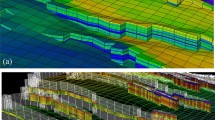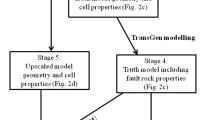Abstract
Flow, mass and energy transport processes in natural reservoirs are controlled to a large degree by the presence of geological heterogeneities including structures such as fractures and fault zones embedded in a spatially varying three-dimensional (3D) porous matrix of the reservoir. Despite recent advances, currently, state-of-the-art models rely on a number of simplifications partly related to our inability to represent heterogeneities as observed in the field into dynamic model realizations. In this respect, an adequate geometric representation of the discrete system is a basic requirement. In this study, we show how fundamental concept from computational geometry can be assembled and used to bridge the gap between geological and dynamic forward models. The result is an automated, open source software solution (MeshIt) to generate quality 3D meshes suitable for the study of flow and transport processes in faulted and fractured reservoirs. The software enables us to integrate into a 3D volumetric representation dip** structures, comprising fault zones and fractures as well as inclined well paths. This permits us to correctly simulate interactions between discrete flow paths along these interacting components and the 3D flow within the reservoir matrix. The crucial factor that makes the approach applicable to real case reservoirs is that all algorithms are local and scalable parallel and have computing times increasing approximately linearly with data volumes. We test the performance and the robustness of the software against three different scenarios of increasing complexity and further discuss current limitations and range of applicability of the software. Although all examples describe geothermal applications, it is worth mentioning that the approach is equally valid for other applications in geoscience from oil and gas industry to carbon capture and sequestration issues.














Similar content being viewed by others
Notes
References
Ahmed T, Meehan N (eds) (2011) Advanced reservoir management and engineering, 2nd edn. Gulf Professional Publishing, Houston
Amenta N, Bern M, Kamvysselis M (1998) A new Voronoi-based surface reconstruction algorithm. In: Proceedings of the 25th annual conference on computer graphics and interactive techniques, SIGGRAPH’98, pp 415–421
Baca RG, Arnett RC, Langford DW (1984) Modelling fluid flow in fractured porous rock masses by finite-element techniques. Int J Numer Meth Fluids 4(4):337–348
Berkowitz B (2002) Characterizing flow and transport in fractured geological media: a review. Adv Water Resour 25:861–884
Blessent D, Therrien R, MacQuarrie K (2009) Coupling geological and numerical models to simulate groundwater flow and contaminant transport in fractured media. Comput Geosci 35:1897–1906
Blöcher G, Cacace M, Lewerenz B, Zimmermann G (2010a) Three dimensional modelling of fractured and faulted reservoirs: framework and implementation. Chemie der Erde Geochem 70(3):145–153
Blöcher G, Zimmermann G, Moeck I, Brandt W, Hassanzadegan A, Magri F (2010b) 3D numerical modelling of hydrothermal processes during the lifetime of a deep geothermal reservoir. Geofluids 10:406–421
Boissonnat JD, Cazals F (2002) Smooth surface reconstruction via natural neighbor interpolation of distance functions. Computational Geometry 22:185–203
Braun J, Sambridge M (1995) A numerical method for solving partial differential equations on highly irregular grids. Nature 376:655–660
Cacace M, Blöcher G, Watanabe N, Moeck I, Börsing N, Scheck-Wenderoth M, Kolditz O, Huenges E (2013) Modelling of fractured carbonate reservoirs: outline of a novel technique via a case study from the Molasse Basin, southern Bavaria, Germany. Env Earth Sci 70(8):3585–3602
Caumon G, Lepage F, Sword CH, Mallet J-L (2004) Building and editing a sealed geological model. Math Geol 26:405–424
Caumon G, Collon-Douaillet P, Carlier Le, de Veslud C, Viseaur S, Sausse J (2009) Surface-based 3D modelling of geological structures. Math Geosci 41:927–945
Chen M, Buscheck T, Wagoner J, Sun Y, White J, Chiaramonte L, Aines R (2013) Analysis of fault leakage from Leroy underground natural gas storage facility, Wyoming, USA. Hydrogeol J 21:1429–1445
Cherubini Y, Cacace M, Blöcher G, Scheck-Wenderoth M (2013) Impact of single inclined faults on the fluid flow and heat transport: results from 3D finite element simulations. Env Earth Sci 70(8):3603–3618
Chew L-P (1989) Constrained Delaunay triangulations. Algorithmica 4:97–108
Committee on Fracture Characterization and Fluid Flow, National Research Council (2006) Rock fractures and fluid flow: contemporary understanding and applications. The National Academic Press, Washington
Davatzes N, Aydin A (2005) Distribution and nature of fault architecture in a layered sandstone and shale sequence: an example from the Moab fault, Utah. AAPG Memoir 8:153–180
De Rooij R (2008) Towards improved numerical modelling of karst aquifers: coupling turbulent conduit flow and laminar matrix flow under variably saturated conditions. Ph.D. thesis, University of Neuchâtel, 130 pages
Dietrich P, Helmig R, Sauter M, Hötzl H, Köngeter J, Teutsch G (eds.) (2005) Flow and transport in fractured porous media, Springer, Berlin
Edelsbrunner H, Mücke EP (1994) Three-dimensional alpha shapes. ACM Trans Graph 13:43–72
Euler N, Sword CH, Dulac JC (1998) A new tool to seal a 3D earth model: a cut with constraints. In: Proceedings of the 68th SEG annual meeting, Society of Exploration Geophyiscists, pp 710-713
Evazi M, Mahani H (2010) Unstructured-coarse-grid generation using background-grid approach. SPE J 15(2):326–340
Farmer C (2005) Geological modelling and reservoir simulation. In: Iske A, Randen T (eds) Mathematical methods and modelling in hydrocarbon exploration and production, vol 7. Springer, Berlin, pp 119–212
Graf T, Therrien R (2008) A method to discretize non-planar fractures for 3D subsurface flow and transport simulations. Int J Numer Meth Fluids 56:2069–2090
Graham RL (1972) An Efficient Algorithm for Determining the Convex Hull of a Finite Planar Set. Inf Process Lett 1:132–133
Hofmann H, Blöcher G, Börsing N, Maronde N, Pastrik N, Zimmermann G (2014) Potential for enhanced geothermal systems in low permeability limestones – stimulation strategies for the Western Malm karst (Bavaria). Geothermics 51:351–367
Holm R, Kaufmann R, Heismund BO, Ian E, Espedal MS (2006) Meshing of domains with complex internal geometries. Numer Linear Algeb Appl 13:717–731
Kaiser BO, Cacace M, Scheck-Wenderoth M (2013) 3D coupled fluid and heat transport simulations of the Northeast German Basin and their sensitivity to the spatial discretization: different sensitivities for different mechanisms of heat transport. Environ Earth Sci 70(8):3643–3659
Kolditz O, Görke UJ, Shao H, Wang W (eds) (2012) Thermo-hydro-mechanical-chemical processes in porous media, 1st edn. Springer, Berlin
Matthäi SK, Geiger S, Roberts SG, Paluszny A, Belayneh M, Burri A, Mezentsev A, Lu H, Coumou D, Driesner T (2007) Numerical simulation of multi-phase fluid flow in structurally complex reservoirs. Geol Soc Lond Spec Publ 292(1):405–429
Merland R, Caumon G, Lévy B, Collon-Drouaillet P (2014) Voronoi grids conforming to 3D structural features. Comput Geosci 18(3–4):373–383
Miller GL, Talmor D, Teng S-H, Walkington NJ, Wang H (1996) Control volume meshes using sphere packing: generation, refinement and coarsening. In: Proceedings of the 5th international meshing roundtable, Pittsburgh, pp 47–61
Möller T (1997) A fast triangle-triangle intersection test. J Graph Tools 2:25–30
Mustapha H, Dimitrakopoulos R (2011) Discretizing two-dimensional complex fractured fields for incompressible two-phase flow. Int J Numer Meth Fluids 65:764–780
Mustapha H, Mustapha K (2007) A new approach to simulating flow in discrete fracture networks with an optimized mesh. SIAM J Sci Comput 29(4):1439–1459
Noorishad J, Tsang C, Witherspoon P (1992) Theoretical and field studies of coupled hydromechanical behaviour of fractured rocks—1. Development and verification of a numerical simulator. Int J Rock Mech Min Sci Geomech Abstr 29(4):401–409
Normani SD, Sykes JF (2010) Paleoclimate analyses of density-dependent groundwater flow with pseudo-permafrost in discretely fractured crystalline rock setting. In: Carrera J (ed) XVII international conference on water resources—CMWR 2010, Barcelona, Spain, 21–14 June
O’Rourke J (1998) Computational geometry in C, 2nd edn. Cambridge Tracts in Theoretical Computer Science. Cambridge University Press, Cambridge
Paluszny A, Matthäi SK, Hohmeyer M (2007) Hybrid finite element-finite volume discretization of complex geologic structures and a new simulation workflow demonstrated on fractured rocks. Geofluids 7(2):186–208
Pellerin J, Lévy B, Caumon G, Botelli A (2014) Automatic surface meshing of 3D structural models at specific resolution: a method based on Voronoi diagrams. Comput Geosci 62:103–116
Prévost M, Lepage F, Durlofsky LJ, Mallet L-L (2005) Unstructured 3D gridding and upscaling for coarse modelling of geometrically complex reservoirs. Pet Geosci 11:339–345
Schomaker V, Waser J, Marsh RE, Bergman G (1959) To fit a plane or a line to a set of points by least squares. Acta Crystallogr A 12:600–604
Segura JM, Carol I (2004) On zero-thickness interface elements for diffusion problems. Int J Numer Anal Meth Geomech 28(9):947–962
Shewchuck JR (2002) Delaunay refinement algorithms for triangular mesh generation. Comput Geom Theory Appl 22(1–3):21–74
Shizake SG, Sudicky E, Schwartz F (1998) Density-dependent solute transport in discretely-fractured geologic media: is prediction possible? J Contam Hydrol 434:273–291
Shreiner D, Sellers G, Kessenich J, Licea-Kane B (2013) The OpenGL programming guide, 8th edn. Addison-Wesley Professional, Essex
Si H (2015) TetGen, a Delaunay-based quality tetrahedral mesh generator. ACM Trans Math Softw 41(2):1–36
Souche L, Lepage F, Iskenova G (2013) Volume based modelling—automated construction of complex structural models. In: 75th EAGE conference and exhibition incorporating SPE EUROPEC 2013 London, UK, 10–13 June
Squillacote A (2008) The Paraview Guide, 3rd edn. Kitware, Inc
Tearpock DJ, Bischke RE (2002) Applied subsurface Geological Map** with structural methods, 2nd edn, Prentice Hall, New Jersey
Therrien R, Sudicky E (1996) Three-dimensional analysis of variably-saturated flow and solute transport in discretely-fractured porous media. J Contam Hydrol 23:1–44
Verbree E (2006) Piecewise linear complex representation through conforming Delaunay tetrahedralization. In: Raubal M, Miller H, Frank A, Goodchild M (eds) GIScience 2006. Springer, Heidelberg, vol 4197, pp 385–388
Zimmermann G, Tischner T, Legarth B, Huenges E (2009) Pressure-dependent production efficiency of an Enhanced Geothermal System (EGS): stimulation results and implications for hydraulic fracture treatments. Pure appl Geophys 166:1089–1106
Zimmermann G, Moeck I, Blöcher G (2010) Cyclic waterfrac stimulation to develop an Enhanced Geothermal System (EGS)—conceptual design and experimental results. Geothermics 39:59–69
Acknowledgments
This work has been performed in the framework of the GeoEn-phase 2 project and funded by the Federal Ministry of Education and research [BMBF, Grant 03G0767A]. A special thank goes to Dr. Si Hang from the WIAS Institute in Berlin for sharing his expertise in the field of mesh generation. The authors would like to acknowledge Prof. Guillaume Caumon whose comments as a reviewer provide valuable to improve not only the quality and scientific merit of the manuscript, but also help finding novel solutions to some aspects of the meshing software.
Author information
Authors and Affiliations
Corresponding author
Rights and permissions
About this article
Cite this article
Cacace, M., Blöcher, G. MeshIt—a software for three dimensional volumetric meshing of complex faulted reservoirs. Environ Earth Sci 74, 5191–5209 (2015). https://doi.org/10.1007/s12665-015-4537-x
Received:
Accepted:
Published:
Issue Date:
DOI: https://doi.org/10.1007/s12665-015-4537-x




